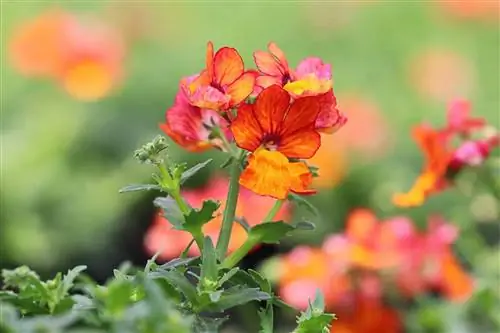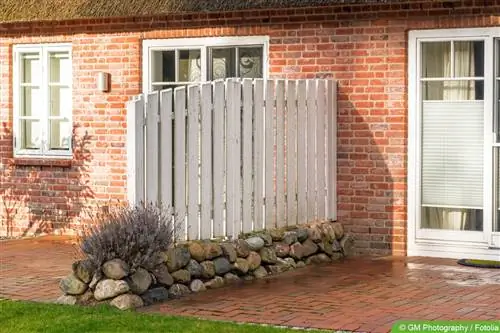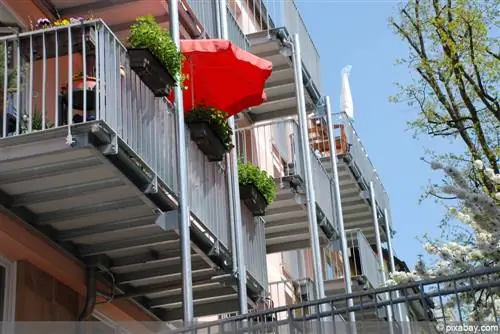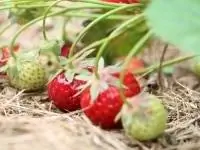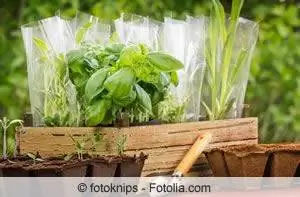- Author admin [email protected].
- Public 2023-12-17 03:39.
- Last modified 2025-01-24 12:45.
The plant has not been on the German market for very long, but is very popular as a true flowering miracle. The plants with their flower umbels in orange, yellow, white or red look particularly good in flower boxes on the balcony. The somewhat more demanding plant thanks good and species-appropriate care with a very lush flower abundance that extends into autumn.
Location for Elf Mirror
In order for the Elfenspiegel to develop optimally and produce perfect flowers, it needs normal garden soil, which should definitely have a pH value of 6.5. As a location, the plant appreciates a sunny and warm place, as it knows from its native areas. It is absolutely important to protect the elf mirror from drafts, as it is extremely sensitive to this. Because the plant comes from warm climates, it should not necessarily be exposed to temperatures below 13 °C to 15 °C. This is particularly important to take into account in spring, when the nights are still very cool. If the elf mirror is exposed to cooler temperatures, this will have a negative effect on the growth of the plant. Basically, you can expect a large abundance of flowers from Elfenspiegel, which lasts from May or June to August. It is a good idea to cut the plant back after the first flowering, as this will ensure that the flowers continue to bloom, which will last until autumn. A bright, sunny and warm location is the ideal condition for the flower development of Elfenspiegel. Drafts must be absolutely avoided.
The most important needs of the elf mirror at a glance:
- Soil with an acid value of pH 6.5
- Temperatures above 13 °C to 15 °C
- regular pruning for lush and long flowers
- Protection from drafts
- ideally a bright and sunny location
Watering and fertilizing the elf mirror
Rich watering is important for the elf mirror. Lime-free and tempered water is particularly beneficial for watering the plant. The plant also appreciates regular spraying with water, which in this case should also be filtered. The Elfenspiegel, on the other hand, cannot tolerate waterlogging at all. Light compost fertilization is recommended for nutrient supply.
Propagation and sowing of the elf mirror
The plant is sown between February and April under glass indoors. If you wait until the end of April to sow, you can do it outdoors straight away. The germination time of the plant is around two to three weeks, although there should be a constant temperature of 12 to 16 °C. After germination, the plant needs a temperature of around 12 °C and little moisture so that it can be cultivated further. Once the plant is present, you can harvest seeds for the next year from the plant itself and then store them in a dry, dark and airy place.
Care of the Elf Mirror
Depending on the weather, the Elfenspiegel must be heavily supplied with filtered water. A commercially available water filter is the ideal solution for supplying the elf mirror with compatible water. The plant should be fertilized weekly. It is important that the plant is watered thoroughly, but that it is never wet. The plant should also be sprayed regularly and only with tempered, lime-free, filtered water. Shortly after flowering, the plant should be cut back and given additional fertilizer so that it then produces abundant flowers a second time. By the way, it is very pleasant that snails generally avoid the elf mirror.
The elf mirror benefits:
- strongly filtered water, preferably from the water filter
- weekly fertilization
- thorough watering without waterlogging
- regular spraying with tempered, lime-free and filtered water
Wintering the Elf Mirror
Generally, the Elfenspiegel, which is also botanically known as Nemesia, is an annual plant. Nevertheless, you can of course try to overwinter the plant. To do this, the plant should be cut back heavily before overwintering. The requirements for the wintering place are that it should be very bright. The cellar is therefore no longer an overwintering place for the Elfenspiegel. The plant also requires a maximum temperature of a maximum of 10 °C. Ultimately, it is also important that the wintering place is dry. If all of these requirements are met, wintering can be successful.
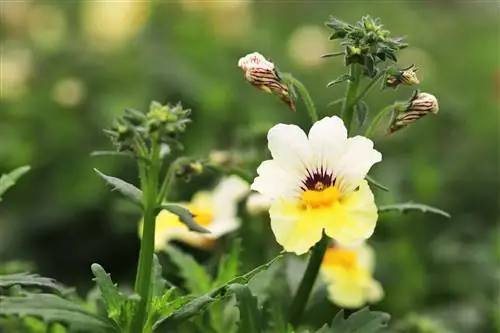
The problem with overwintering the plant is that the purchased specimens are supplied with so-called shrub agents, as inhibitors that prevent the extremely strong growth. This can significantly affect growth when pruned heavily next spring. The second problem with overwintering is that plants react very sensitively to air humidity, especially in winter, and therefore also to the formation of moisture in the substrate. If there is intense moisture, this can ultimately lead to the plant not surviving the winter.
The elf mirror needs it for overwintering
- a bright location
- a previous strong pruning
- an ideal temperature of a maximum of 10 °C
- an absolutely dry location
What you should know about the elf mirror in brief
The elf mirror is a very beautiful and, above all, lush flowering plant from May/June to August. If you cut the plants back after the first flowering, you can achieve further flowering until autumn. The flower spikes can be 25 to 60 cm long. In order to achieve these successes, the demands on care and location must be taken into account. Even during the winter, the Elfenspiegel requires a lot of sensitivity.
- The origin of the elf mirror lies in southern Africa. It belongs to the pharyngeal family.
- The annual plant has not been on the German market for very long. It is a true flowering miracle.
- The white, yellow, orange or red flower umbels look good in any balcony box.
- There are numerous varieties: dwarf specimens form dense flower cushions.
- Bushy plants, on the other hand, stand out thanks to their large, funnel-shaped flowers.
- The plants grow very quickly and easily into round, richly blooming flower balls.
Location and growing conditions
- The elf mirror prefers normal garden soil, if possible with a pH of 6.5.
- The location should be sunny and warm.
- The elf mirror must be protected from drafts, but the plant still needs plenty of fresh air.
- Night temperatures below 13 to 15 °C have a negative effect on plant growth.
Watering and fertilization
- The elf mirror needs plenty of water. If possible, lime-free, tempered water should be used for watering.
- Only filtered water should also be used for regular spraying of plants. Waterlogging is not tolerated.
- Light compost fertilization is recommended. Temperatures above 18 °C limit flowering.
Propagation
- Sown under glass between February and April. From the end of April you can also sow outdoors.
- The germination period is 2 to 3 weeks, ideal germination temperatures are 13 to 16 °C.
- Then continue to cultivate below 12 °C and with little moisture.
- Seeds can also be obtained from your own plants. All you have to do is harvest the ripe seeds from your plants in the fall.

